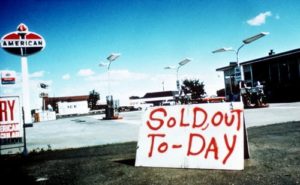“We aren’t addicted to oil, but our cars are.” – James Woolsey, national security and energy specialist
Wake up World! Do something!
December 1973. Oil embargo. Panic. Fighting at the pumps. Mile long line-ups at refueling stations in cities everywhere. Petrol, petrol everywhere –underground-, but not a drop to burn. Frustration. — Is this life without oil?
When a few small countries use “oil as a weapon” to squeeze huge price increases from the large part of the world that depends on the black goo for its economic survival —and get away with it, … … Do you know of any wrongdoer who reversed his wicked ways after his first bank heist and gave his riches to charity?

From the American Petroleum Institute
In the years after the 1973 oil embargo, various governments, research institutions, automobile companies, and individuals, not necessarily in that order, hesitantly started to realize that they must find a solution to the increasing likelihood of future petroleum shortages, for whatever reason. As well, pollution from all sources, but mostly blamed on the automobile because of its familiarity and visibility, became a touchy issue in many circles. Governments started to legislate ever more stringent emission control regulations for the auto industry.
During the 1970s and 1980s, a number of automotive companies and organizations started to convert engines to burn hydrogen. They had been reassured by a trusted official agency –NASA- of the safety of hydrogen. As well, NASA had disproved the falsehood that hydrogen had caused the Hindenburg disaster. Sadly, that myth lingers on in uninformed circles.
The Los Alamos National Laboratory had modified, converted, and experimented with a 1979 Buick to burn hydrogen in its internal combustion engine. Under Walter Stewart, the distinguished laboratory had concluded that “hydrogen storage and refueling of a vehicle can be accomplished over an extended period of time without any major difficulty”. The staff, scores of people, had refilled the car over a three-year period at a self-serve liquid hydrogen pump.
Sporadic attempts to use other than petroleum fuels –‘Alternative Fuels’– had taken place here and there by “tinkerers”, and even an occasional scientist or engineer. Nevertheless, until this time, experimentation with hydrogen as a fuel had generally been done on a scientific and experimental scale. Little thought had been given to the possibility that it might soon become a necessity, even less that an industry would grow around H2.
“That sounds safe enough”, most everybody thought, and a period of trial and error got underway. Companies and individuals began to experiment with alternative fuels, started to generate hydrogen gas by using various methods and converted IC engines to use Hydrogen and its offshoots as a fuel. A few companies made serious attempts, but most became complacent again when the ‘black gold’ started to flow again and future petroleum supply seemed reasonably assured.
Japan depends on other countries for 80% of its energy supply, and for that reason, it was one of the pioneer nations to look seriously into what we now group under alternative fuels. The first hybrid-electric cars came from that “Johnny-come-lately” in the automotive industry, Japan.
Next: Canada influences Hydrogen & Fuel Cell History
Comments are closed here.
